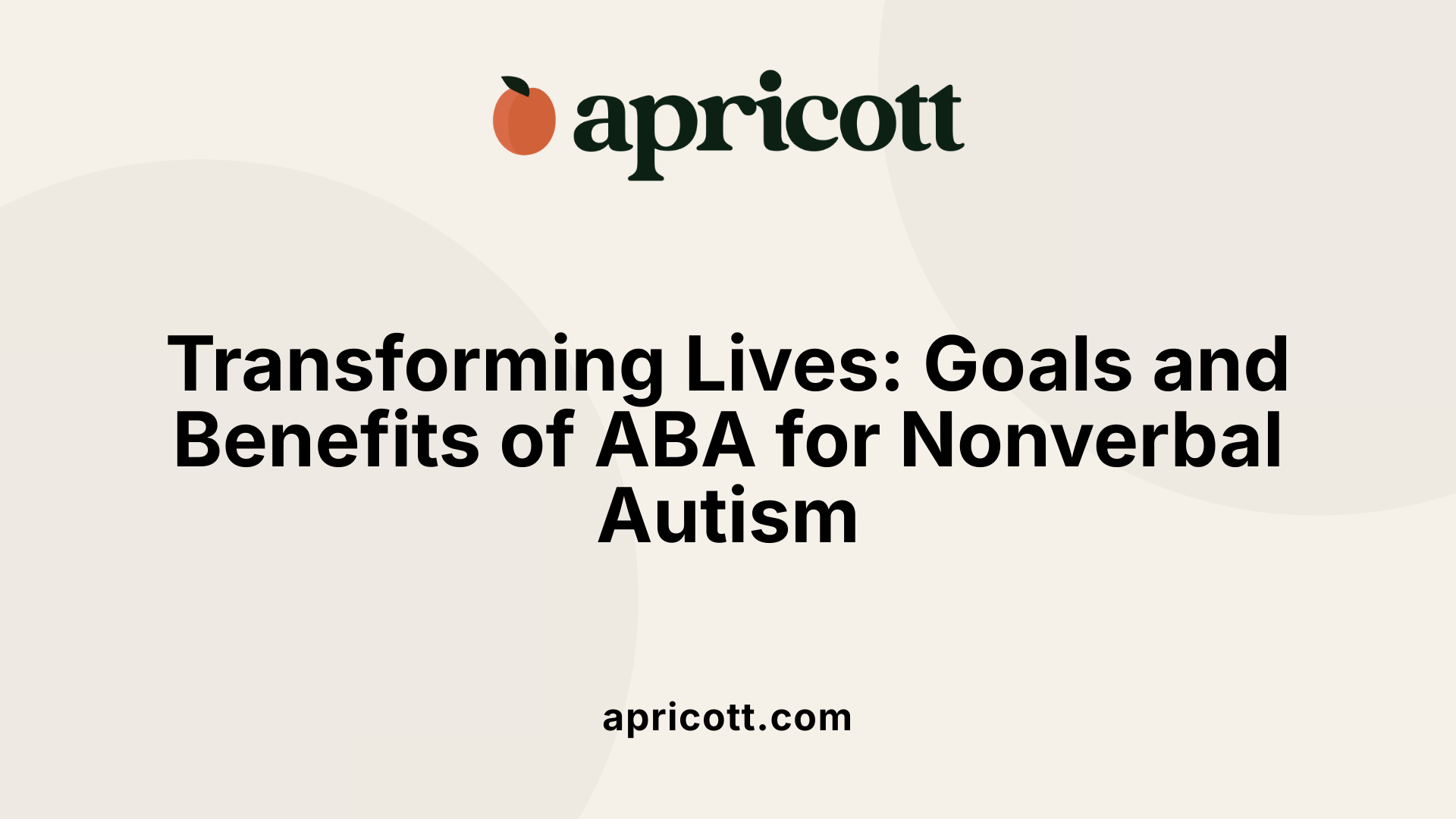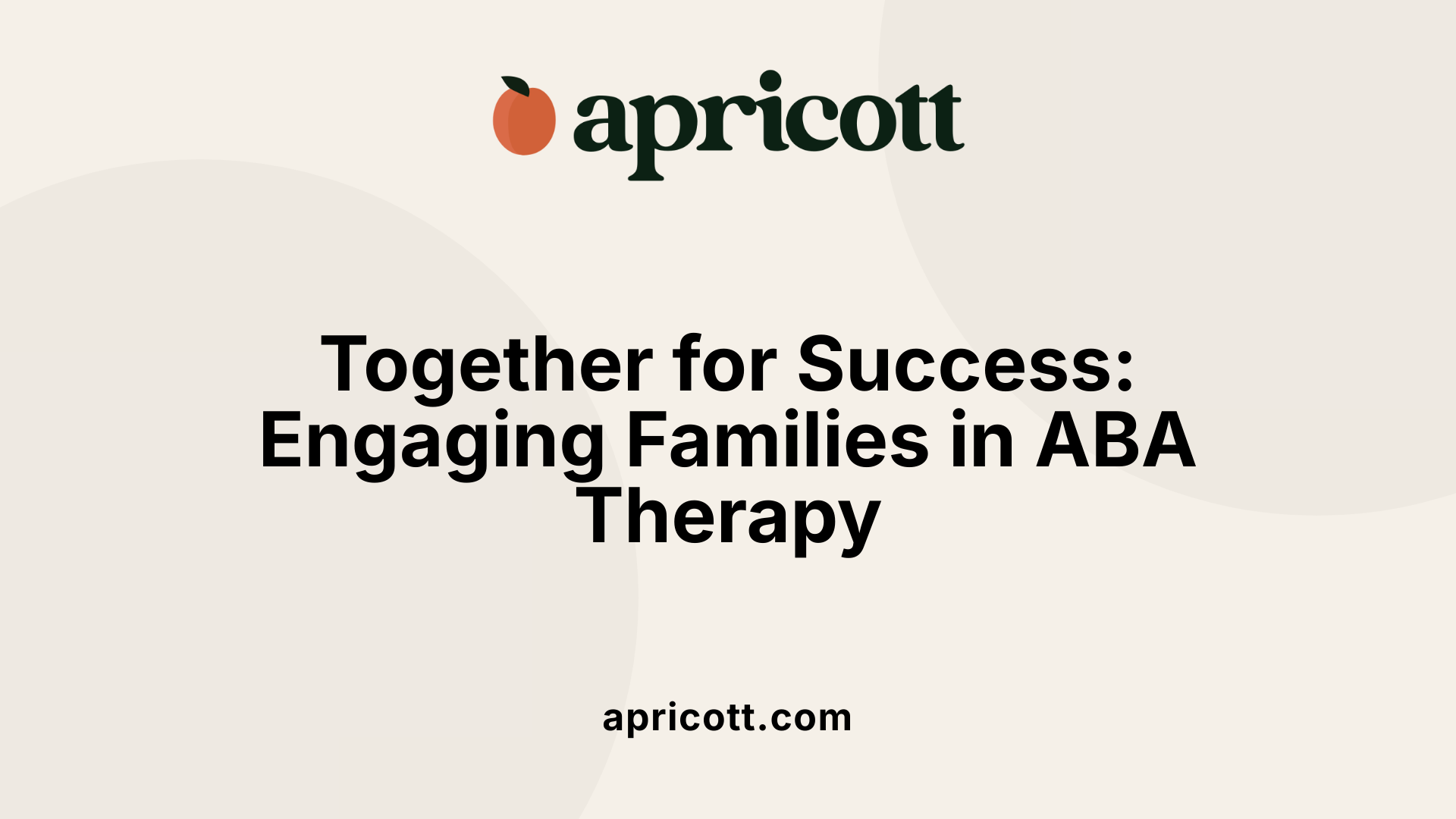Understanding Nonverbal Autism and the Promise of Behavioral Therapies
Nonverbal autism presents unique challenges, especially in communication and social interaction. As families and professionals seek effective interventions, Applied Behavior Analysis (ABA) emerges as a scientifically validated method that helps individuals with nonverbal autism develop crucial skills. This article explores how ABA therapy is tailored to support nonverbal individuals, the roles families play in the therapy process, and the broader scope of behavioral and developmental treatments designed to improve quality of life.
Applied Behavior Analysis (ABA) Therapy: Foundations and Use in Autism Treatment
What is applied behavior analysis (ABA) therapy and how is it used in treating autism?
Applied Behavior Analysis (ABA) therapy is a scientifically grounded method for understanding and influencing behavior, especially in individuals with autism spectrum disorder (ASD). Rooted in learning theory and operant conditioning, ABA is designed to boost helpful behaviors such as communication skills, social interactions, and daily living abilities, while reducing behaviors that might be harmful or interfere with functioning.
How does ABA therapy work?
ABA therapy operates by carefully analyzing the connection between antecedents (what happens before a behavior), the behavior itself, and the consequences that follow—a framework known as the A-B-C model. This approach allows therapists to identify factors triggering behaviors and adjust the environment to encourage positive changes.
What techniques are used in ABA?
One of the most prominent techniques in ABA is positive reinforcement, where desired behaviors are promptly followed by meaningful rewards, increasing the likelihood these behaviors will be repeated. Therapists often use structured teaching, such as discrete trial training (DTT), breaking skills down into small, manageable steps with clear instructions and rewards. Other methods, like pivotal response training (PRT), promote learning within natural settings and focus on critical skills like motivation and communication initiation.
How are ABA programs individualized?
ABA therapy programs are personalized based on the individual's unique skills, needs, and interests. A qualified professional, typically a Board Certified Behavior Analyst (BCBA), assesses the individual and sets goals that may address communication, social skills, self-care, play, motor abilities, or academics. The program adapts with ongoing data collection to monitor progress and refine approaches.
In what settings is ABA therapy provided?
ABA services are flexible and can be offered in various environments including the home, school, clinics, and community settings. This adaptability helps facilitate generalization of skills across different real-life situations.
What outcomes can be expected from ABA therapy?
Research and clinical experience have shown that intensive, long-term ABA therapy can produce measurable improvements in language proficiency, cognitive abilities, social communication, and daily living skills. It is widely recognized as an evidence-based best practice for autism treatment by major health organizations.
| Aspect | Details | Additional Information |
|---|---|---|
| Science Basis | Learning theory and operant conditioning | Developed notably by Ole Ivar Lovaas in the 1970s |
| Behavioral Framework | A-B-C model (Antecedent-Behavior-Consequence) | Helps in analyzing and modifying targeted behaviors |
| Techniques | Positive reinforcement, DTT, PRT | Structured and naturalistic methods combined |
| Program Design | Individualized with BCBA oversight | Goals cover communication, social, self-care, and more |
| Settings | Home, school, clinic, community | Supports learning across environments |
| Expected Outcomes | Improved language, social skills, daily functioning | Supported by over 20 studies demonstrating effectiveness |
Who Delivers ABA Therapy? Expertise Behind Effective Autism Treatment

Who typically provides ABA therapy services?
ABA therapy services are usually delivered by qualified professionals with specialized training in behavioral analysis. The primary providers are Board Certified Behavior Analysts (BCBAs), who design and oversee individualized treatment plans tailored to each person's unique needs and goals. These experts lead the assessment of skills and monitor progress through ongoing data collection.
What is the role of BCBAs in ABA therapy?
BCBAs play a crucial role in ensuring the effectiveness and safety of ABA programs. They design intervention strategies based on the principles of learning and behavior, train therapists, and make adjustments according to the individual's response to treatment. Their involvement guarantees that programs maintain fidelity to evidence-based standards.
How are ABA providers accredited and held to quality standards?
Many ABA providers seek accreditation from reputable organizations such as the Behavioral Health Center of Excellence (BHCOE). Such accreditation affirms adherence to high-quality clinical practices, staff qualifications, and ethical guidelines. This professional recognition fosters trust among families and healthcare providers.
In what settings and by whom is ABA therapy delivered?
ABA therapy is flexible and can be provided in a variety of settings including clinics, homes, schools, and community environments. Trained therapists, under BCBA supervision, implement interventions directly with clients. Additionally, telehealth services are increasingly utilized to improve accessibility.
How is ABA therapy integrated with insurance and healthcare systems?
ABA is recognized as an evidence-based treatment for autism and is often covered by private insurance and Medicaid when deemed medically necessary. Healthcare providers typically guide families through the authorization and service coordination process, ensuring access to qualified ABA professionals.
What professional training and program development support ABA therapy?
Providers undergo rigorous training in the science of behavior analysis and specialized ABA techniques such as positive reinforcement and the ABC model (antecedent-behavior-consequence). Programs are customized through collaboration among analysts, therapists, families, and caregivers to maximize meaningful skill development in communication, socialization, and daily functioning.
| Provider Role | Key Attributes | Typical Setting(s) |
|---|---|---|
| Board Certified Behavior Analyst (BCBA) | Designs programs, supervises, and tracks progress | Clinics, schools, homes |
| ABA Therapist | Delivers direct intervention under BCBA supervision | Homes, clinics, schools |
| Accredited Provider Programs | Meet high-quality practice standards | Community, telehealth |
ABA therapy's success is founded on the expertise and collaborative efforts of skilled professionals dedicated to delivering individualized, evidence-driven care for those with autism.
Tailoring ABA Therapy to Meet Individual Needs in Nonverbal Autism

How is ABA therapy tailored to meet individual needs?
Applied Behavior Analysis (ABA) therapy is carefully customized to suit the unique needs of each individual, especially important for addressing nonverbal autism. This personalization begins with thorough assessments by qualified behavior analysts (BCBAs). They evaluate a person's strengths, challenges, and specific behavioral patterns using methods like the A-B-C model (antecedents, behavior, consequences).
Based on this detailed analysis, BCBAs develop treatment plans targeting vital areas including communication and social skills, self-care, and academics. Goals are highly specific, focusing on foundational abilities such as initiating communication and improving social interactions.
ABA therapy is flexible and can be adapted to different environments such as the home, school, or community settings. This ensures that interventions remain relevant and effective within the individual's daily life contexts.
Continuous data collection and progress monitoring are central to ABA. Therapists track responses and outcomes, enabling adjustments to strategies and goals to maximize success.
Positive reinforcement is tailored to each person's preferences—rewards are meaningful and motivating to encourage desired behaviors. For example, a favorite toy or praise might be used to reinforce a child's efforts in communication.
In summary, ABA's individualized approach integrates professional assessment, customized goals, environmental adaptability, ongoing data use, and personalized positive reinforcement to best support nonverbal individuals with autism in achieving meaningful developmental progress.
Goals and Benefits of ABA Therapy for Nonverbal Individuals with Autism

What are the common goals and benefits of ABA therapy for individuals with autism?
ABA therapy aims to improve communication skills, especially important for nonverbal individuals, by teaching alternative and functional ways to express needs and wants. Social skill development is another focus, helping children engage more successfully with peers and adults.
Daily living skills are targeted to enhance independence in self-care activities such as dressing, eating, and hygiene. These skills increase autonomy and reduce dependence on caregivers.
A major goal is also to reduce problematic behaviors that interfere with learning and social interaction. ABA uses positive reinforcement to encourage desirable behaviors while decreasing harmful or hindering actions.
Ultimately, these improvements contribute significantly to the enhancement of quality of life. Children benefit from increased confidence, better routines, and more positive social experiences, leading to greater participation in their communities.
Empirical evidence strongly supports ABA’s effectiveness. Numerous studies demonstrate gains in cognitive, language, social, and daily living skills, with improvements reported in 63%–88% of cases. ABA therapy is individualized and data-driven, ensuring that interventions meet the unique needs of each child to yield meaningful progress.
By focusing on reinforcing foundational behavioral skills, ABA therapy provides a comprehensive approach that helps nonverbal individuals with autism communicate better, develop meaningful social relationships, live more independently, and enjoy a higher quality of life.
Caregiver and Family Involvement: A Partnership for Success in ABA Therapy

What role do families and caregivers play in ABA therapy?
Families and caregivers are essential partners in the ABA therapy process. They often receive training and coaching from therapists to confidently apply behavior strategies in everyday situations. This active participation helps the child practice and reinforce new skills not only during therapy sessions but also at home and in the community, supporting generalization of learning.
How does communication between caregivers and therapists enhance ABA outcomes?
Open and consistent communication allows caregivers to share observations and challenges, while therapists provide guidance and adjust therapy plans accordingly. This two-way exchange enables a tailored approach that responds to the child's evolving needs and promotes more effective skill acquisition.
Why is promoting consistent reinforcement important in family involvement?
When caregivers consistently reinforce positive behaviors using strategies like positive reinforcement, children are more likely to repeat and maintain those behaviors. This consistency across settings creates a supportive learning environment vital for lasting progress.
How can families balance involvement in ABA therapy to prevent burnout?
While engagement is critical, caregivers should balance their involvement by pacing their efforts and seeking support when needed. This prevents exhaustion, allowing them to sustain their active role in supporting the child's development over time.
Fostering a collaborative environment between therapists and families empowers children receiving ABA therapy. It enhances skill generalization, maintains consistent reinforcement, and supports holistic progress toward independence and improved quality of life.
Complementary Therapies and Approaches Supporting Nonverbal Autism

What developmental approaches can support nonverbal autism?
Developmental approaches such as the Early Start Denver Model (ESDM) provide broad, evidence-based support by integrating behavioral and developmental strategies. ESDM focuses on improving language, social, and cognitive skills through play and natural interactions, involving parents and therapists working together in daily routines.
How does speech and language therapy assist nonverbal individuals?
Speech and language therapy aims to build both verbal and non-verbal communication skills. Techniques include augmentative and alternative communication (AAC) to support effective expression. This therapy also targets social language skills, helping individuals navigate conversations and social interactions.
What role does occupational therapy and sensory integration play?
Occupational therapy helps individuals develop essential self-care skills like dressing, eating, and bathing, promoting independence and mental health. Sensory integration therapy, a component of occupational therapy, focuses on managing sensory processing challenges often present in autism, improving overall comfort and engagement.
Which social-relational models and social skills groups are used?
Social-relational approaches, including models like Relationship Development Intervention (RDI) and social skills groups, aim to foster social interaction, emotional bonding, and flexible thinking. These approaches often involve caregivers as active participants, enhancing the transfer of skills into everyday life.
Why is combining various interventions important?
Using a combination of developmental, behavioral, and social-relational therapies ensures a comprehensive approach tailored to each individual's strengths and challenges. Integrating therapies like ABA with speech, occupational, and social skills interventions maximizes overall progress in communication, behavior, and daily functioning for nonverbal individuals.
Challenges and Future Directions in ABA Research and Practice for Autism
Limitations of Current Studies and Small Sample Sizes
Most ABA research studies on autism involve small sample sizes, often fewer than five participants, which limits the generalizability of results. Many use single-case experimental designs (SCEDs) that provide detailed observations but lack broader applicability across diverse populations.
Need for Large-Scale Randomized Controlled Trials
Only about 4% of studies incorporate comparison groups or conduct randomized controlled trials (RCTs). These large-scale studies are essential to confirm the effectiveness of ABA compared to other interventions and to establish stronger evidence bases.
Long-Term Outcomes and Quality of Life Assessments
Current research frequently overlooks long-term impact and quality of life (QoL) measures. Assessing these outcomes is vital to understanding how ABA affects sustained development and everyday functioning beyond immediate behavioral changes.
Research Gaps in Generalization and Maintenance
There is a notable gap regarding how well skills acquired through ABA generalize to new environments and maintain over time. Addressing these gaps will improve the durability and practical benefits of ABA interventions.
Ongoing Efforts to Refine ABA Models and Measurements
Researchers and clinicians are actively working to enhance ABA models by integrating comprehensive assessments and incorporating naturalistic, developmental strategies. Efforts focus on tailoring ABA to individual needs and measuring both behavioral improvements and broader life outcomes to ensure lasting effectiveness.
The Path Forward in Supporting Nonverbal Autism
Applied Behavior Analysis therapy remains the cornerstone of evidence-based intervention for individuals with nonverbal autism, offering tailored approaches that significantly enhance communication, social skills, and independence. The active involvement of families, combined with skilled providers and complementary therapies, builds a comprehensive support system fostering meaningful progress. Continued research and innovation are essential to further improve long-term outcomes and quality of life, ensuring that every individual with nonverbal autism receives personalized, effective care that unlocks their full potential.
References
- Applied Behavior Analysis (ABA)
- Treatment and Intervention for Autism Spectrum Disorder
- Applied Behavior Analysis in Children and Youth with Autism ...
- Treatment Options
- Behavioral Therapy for Autism Spectrum Disorder in Children
- Types of Therapy for Autism: 5 Options for Autistic Kids
- The Role of Caregiver Involvement in ABA Therapy
- Helping Parents Understand Applied Behavior Analysis
.svg)
.svg)








